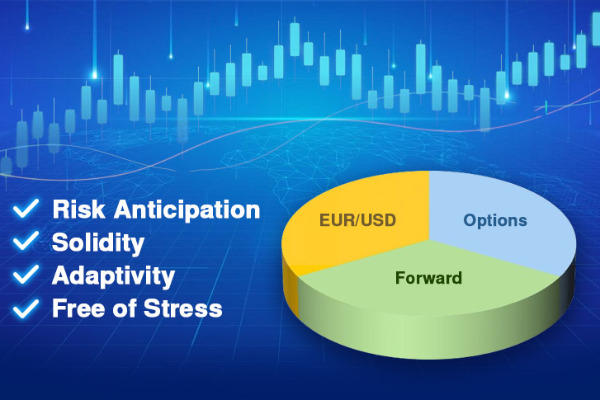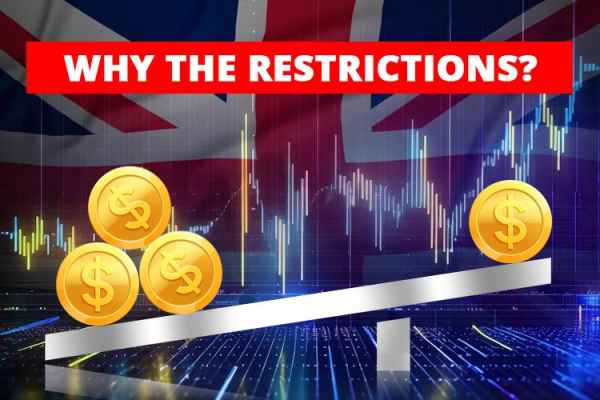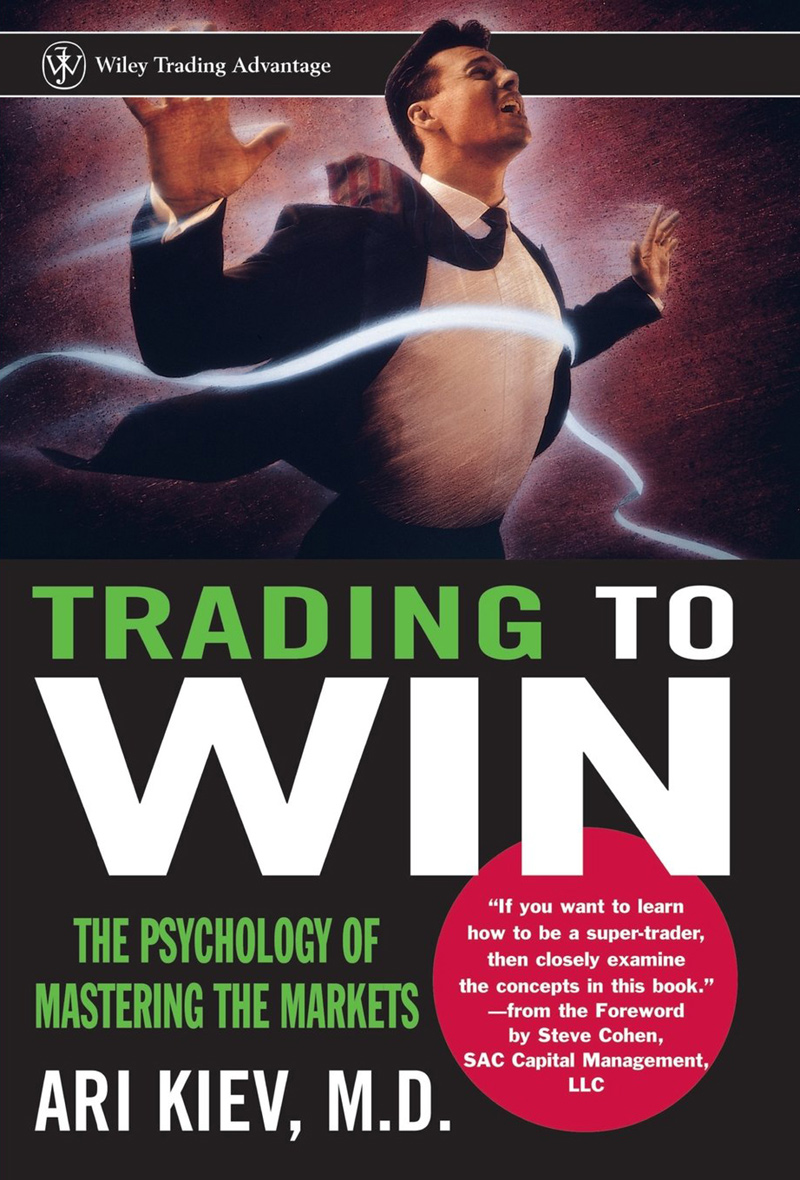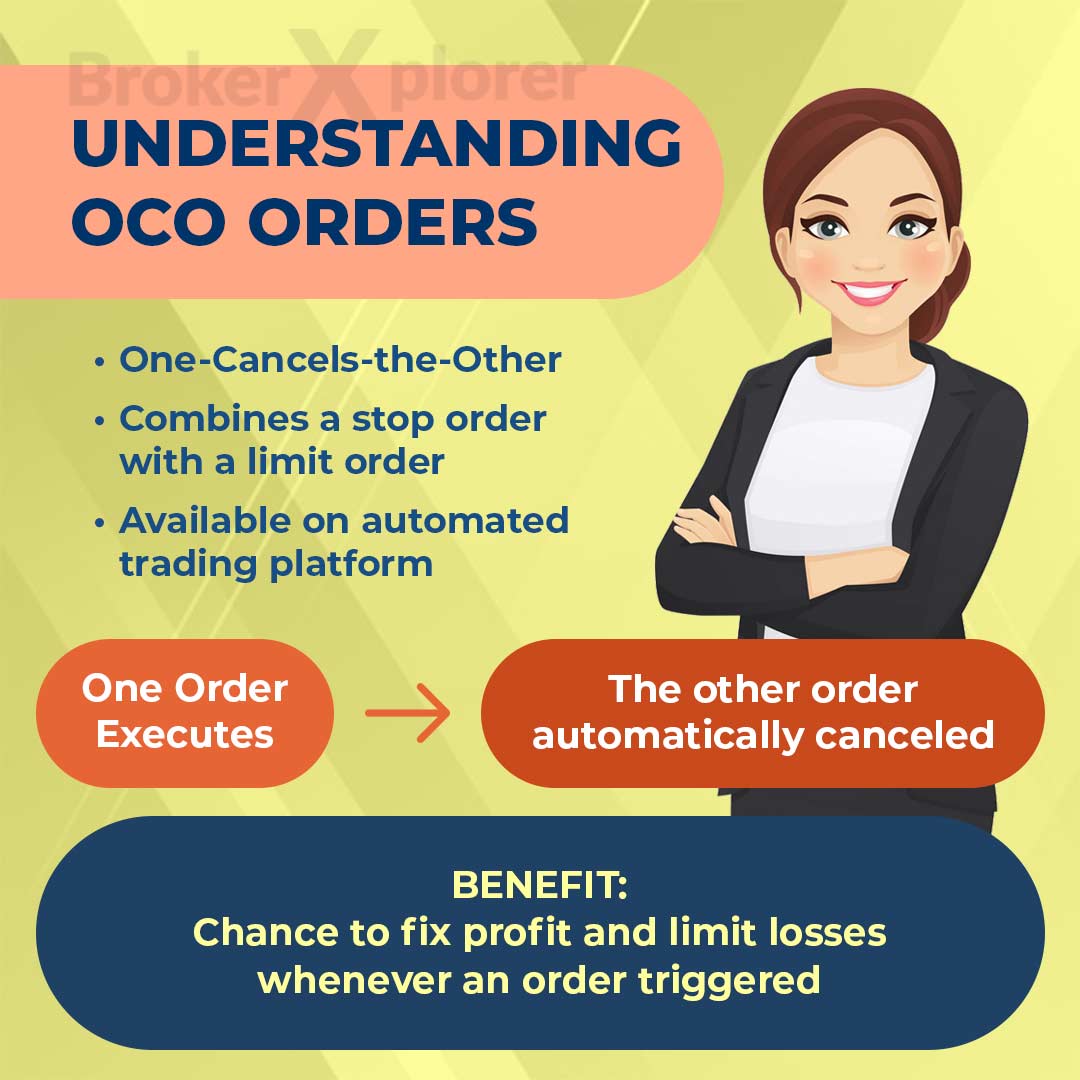About 90 percent of forex traders lose money. However, their mistakes can be avoided if they are aware of them and try to anticipate or fix them right away.
Statistically, most forex traders lose their money with astoundingly alarming figures; they can reach up to 90-95 percent. Although the figure and data are not exactly reliable (since most of the information is obtained from brokers' data), one thing we can be certain of is that the majority of forex traders experience losses and only a few of them earn profits consistently.
It can be hard to believe that most traders who lose their money are not because they don't understand technical and fundamental analysis nor about how to trade correctly. A lot of these traders have been trading on demo accounts for quite some time. They have also implemented money management and executed trading plans, but are still unable to generate profits consistently. From the surveys conducted, most of these traders made lots of small, but frequent common trading mistakes. Here are the lists:
- Not understanding the market drivers
- Trading on small time frame
- Ignoring details
- Too many experiments
- Moving stop loss to breakeven
- Underestimating exit strategy
- Spontaneous trading changes
- Too many indicators
- Unrealistic profit target
- Too reliant on software
- Addicted to new strategies
- No long-term goal
- Inconsistent risk management
- Overconfidence
- No trading routine
- Misconception of day trading
- Overtrading
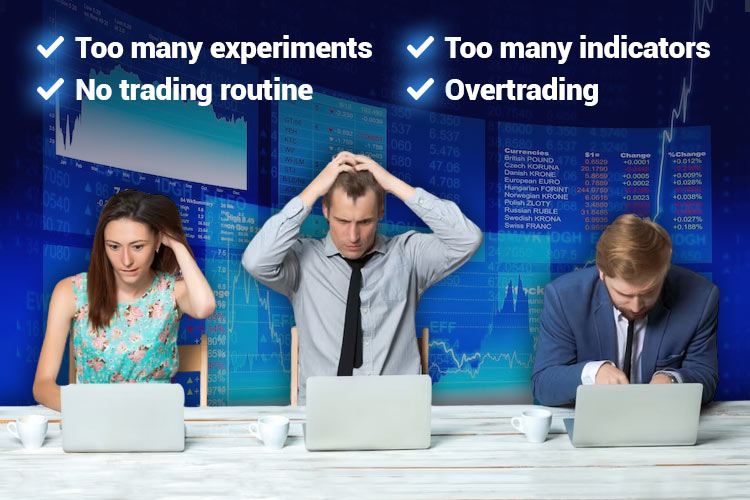
Although small, those mistakes do affect the result. In other words, small mistakes can be very fatal. Even worse, they can cause you to lose confidence over time. Let's discuss everything on the list one by one.
1. You don't know the factor that causes the price moves.
This is the most common mistake. Many traders know a lot about forex market but don't understand what causes price movements. In this case, you should learn about the supply and demand on the forex market, how pending orders fill market orders, how big banks and brokers make transactions based on trading volume, and so on. Basic and complete knowledge of forex trading mechanisms will be very helpful in understanding market price movements.
2. You only trade on the 1-hour time frame.
Lots of traders apply the "hourly strategy" or focus on the 1-hour time frame. That is why the popular MetaTrader platform always displays the 1-hour time frame (H1) in its default state. By only focusing on one short-term trading time frame like that, you will not know the direction of the overall market price movement.
You should also look at a higher time frame (4-hour, daily, or even weekly) to find out the direction of the long-term trend. For setting the entry points, stop loss, and profit targets, you can set them on your favorite time frame. By analyzing the price on multiple time frames, you will be able to avoid unnecessary errors caused by a narrow perception of the price movement.
3. You don't care about the details of the strategy, the expected profit figures, and the average trades per month.
A good trader must know even the most nitpicky detail that is related to their trades. Sometimes, traders simply use the trend following strategy when the market is moving or vice versa, which in turn, failed to bear the expected results. Understanding your strategies in detail will make it easier to navigate the current market conditions. Besides, you also have to know the expected profit or expectancy figures of each strategy you use.
To find out the expected profit figures, you must know the percentage of profit from the whole trade or winning trades (W%) and the percentage of loss from the whole trade or losing trades (L%).
Note that the average profit in a winning trade is Av W (in units of money value) and the average loss is Av L (in units of monetary value).
Expected profit rate = (W% x Av W) - (L% x Av L) (in terms of monetary value)
To find out these parameters, you have to test a trading strategy for some time. It usually takes several weeks to months if you are forward-testing in a live account. But if you are back-testing in a demo account, you may get the result quicker as the data have been gathered previously in the platform. Still, it is imperative to understand that strategy testing based on past data is relatively less relevant than if you are testing it using both past and present data.
4. You're always experimenting with new trading strategies.
Maybe this is a mistake that is often found in retail traders. Switching from strategy to strategy is like trying out a new hat to improve your game of golf. In other words, the losses you often experience may not be due to the strategy. When you choose a strategy, you need to consistently implement the strategy and adhere to its rules. Otherwise, you may not be able to make it works no matter how high its profit expectancy is.
5. You move stop loss to a breakeven point when you're in profit to avoid losses.
This small mistake can say a lot about a trader's amount of profit expectancy. This action is commonly motivated by fear of loss and eventually limits the chances of gaining more profits. For example, let's say the market is trending and you have made a few pips. You move the stop loss level to the breakeven point. The price movement then goes into a correction phase and touch your stop loss level, so your trade ends in a breakeven. You do not lose, but you also do not gain any profit. So, if you want to keep some profits in case of a sudden volatility jump, it is better to move your stop loss in a profitable price level instead of in a breakeven position.
6. You have developed a good strategy for entry without a good or any exit strategy.
Many traders make entry strategies very carefully with various rules involving technical and fundamental analysis. For example, they analyze new releases of fundamental data and decide the best time to enter the market and so on, but they ignore the exit strategy or don't even have a picture of the exit strategy at all.
This error can limit their chance of profit (when it is profitable), or result in a greater loss. A simple way to determine an exit strategy is to pay attention to support and resistance levels as a limit to price movements. The exit level can be around the closest support or resistance level depending on the market conditions.
7. You frequently change trading setups on a whim.
Often time, traders are fixated on what has just happened and forget the entry positions that were planned according to the previous analysis. They will spontaneously open a new position just because the price movements are more promising. This sort of thing will of course mess up the trading plan despite how "perfect" the market condition seems to be.
Hence, it is not uncommon for traders to end up regretting their new position. Apart from changing and opening new positions impulsively, traders often change their stop loss level or profit target for fear of losing or not making enough profit. This seemingly trivial error will have a huge impact on the overall trading result.
8. You apply many technical indicators for fear of being wrong or afraid of losing momentum.
Each technical indicator is based on different analytical principles. Two different indicators may often show conflicting trade signals, in which one indicates to buy while the other confirms a sell signal. The application of more than one indicator is usually to confirm signal from each other, for example, the oscillator (RSI, Stochastic) cannot accurately indicate a trend compared to ADX or other trend indicators. Meanwhile, ADX tends to lag (slow) in its anticipation compared to RSI.
If you are familiar with technical indicators, try to use no more than 2 indicators. The application of multiple indicators in practice often causes conflicting interpretations and provides confusing trading signals. It is also important to note that a combination of indicators that can work well in certain conditions and time frames may not necessarily work well in different market conditions.
9. You expect big profits from a small account.
One of the most common lies in the forex industry is that every trader can make multiple profits with relatively small capital. It actually can happen in some cases, but not in the long term. Based on historical data, successful forex traders make the most by getting consistent profits in the long term, not a single big profits in the short term.
If you consider forex trading a sensible investment, you should also prepare your capital realistically to make a reasonable profit. Joe DiNapoli, a successful trader always advice traders that before you can earn profit, you should concern yourself with protecting capital first.
10. You're too dependent on trading softwares without knowing the details of the softwares.
Some trading softwares are made based on technical analysis, and as mentioned before, technical analysis that worked well in certain conditions and time frames does not necessarily mean it also works well in different market conditions.
If you use certain software and it doesn't work properly, it doesn't necessarily mean the software is a "scam", you may just don't understand the details of the specifications; on what market conditions it can be applied and on which time frame it should operate. Even then, you still have to determine the profit and loss target according to the risk management that you have planned. In fact, if there is software that promises to be a "holy grail" and can be applied to all market conditions, the software is likely a scam.
11. You're addicted to trying out new methods or strategies from other sources.
With the fast distribution of information that we can enjoy today, it is very likely that you may stumble into a number of sources about many interesting trading strategies that seem to be promising with a high chance of profitability. It may entice you to try out all of them.
This is almost the same as what we talk in point 10, but it is actually different. Usually, traders who act like this are those who are smart enough and have decent knowledge background. They don't think the trading software offered is all a scam, but dabbling in new trading strategies and systems too often.
For example, let's say Robert is an accomplished golfer who already has a good shot technique with excellent results. When he saw a video clip of Tiger Woods explaining how the position and movement of the wrist could increase the power of the hit, he tried the technique. After several attempts, it turned out that the results were not what he expected. Then he returned to using his original technique. Some time after, he saw Phil Mickelson's interview about the correct hitting technique and he tried to copy it. In a short time, Robert had different hitting techniques but all of the results were not what he expected.
It's not that Tiger Woods or Mickelson lied as they used their techniques to improve the quality of their hit. It just means that what works for other golfers does not necessarily work for Robert because they are different people who have different styles and characteristics.
The same thing goes for every forex trader. Trying methods or strategies from other professional traders does not guarantee instant success. You can't mirror what professional traders have just by copying their methods because they have years of experience in the market. Instead of spending your time jumping from one trading method to another, invest your time and money in perfecting your own trading strategy that has been proven profitable.
See Also:
12. You don't have a strategy to increase the growth of your trading account.
Unconsciously, many traders just want to win some trades without a clear plan for developing their accounts. If you want to be a successful trader in the long run, you must have a specific strategy on how you should grow your account with clear profit targets over a certain period of time.
For example, you notice that a certain amount of risk will lead to a total so you plan to reduce the risk if it reaches that certain level. You will withdraw some of your funds after the account grows into a certain number, and so on. Having a plan to grow your account in the long term will make you focus more on these goals and not just thinking about daily profit. After all, trading is not a single day business.
13. You apply inconsistent risk management.
You should set specific rules to determine your risk tolerance. The amount of risk shouldn't just simply be determined based on the percentage of the account balance for each trade. Set the risk management system that is most likely acceptable for you. Also, make sure that the amount of risk in a trade with high probability should be different from one with low probability.
14. You always tell yourself that you're a good trader.
This excessive confidence is really common among new traders. This often makes traders stop learning while in fact, market conditions change from time to time. The strategies you use today may not necessarily be able to be implemented smoothly in the next few months. Your goal is to become a successful trader but you can never achieve that goal if you think you have been a good trader all along.
15. You don't do trading activities regularly.
In reality, we have never met a successful trader who is not disciplined and did not carry out trading activities regularly. Routines are very important. Even if you are not currently trading at the time, you need to maintain a schedule as simple as viewing the trading charts or reading some fundamental news. Discipline is an integral part of achieving consistent trading results.
Like it or not, trading in the forex market requires routine and high discipline. If success in forex trading is like a tree, discipline is the root. The three main traits produced by a disciplined trading habit are consistency, confidence, and patience. Those key factors will generate profits in the long run.
Maybe you are still looking for the most profitable trading methods or setups, so you tend to switch strategies if the results are not sufficient. Trading without proper direction such as that will indeed be boring, and boredom is the main killer factor for trading, in which they must be avoided.
16. You simply have to enter the market today because you are a day trader.
Forcing yourself to open a trade when the market conditions do not match the criteria for entry can reduce your probability or result in a big loss. Even though you are a day trader, you don't have to trade every day or set a daily profit target. Opportunities don't always come every day and these mistakes, in the long run, can be fatal. The point of day trading is to open and close position in the same day, not to trade every day. If you don't find a good trading signal today, then look for a more profitable chance tomorrow.
17. You tend to overtrade with multiple entries and exits.
Overtrading is usually caused by an emotional way of trading, and is a very common issue among forex traders, especially for beginners. Traders with inconsistent trading results tend to experience frequent losses and are usually overtrading without even realizing it. It can also be caused by traders' tendency to use small time frames (below daily) which seemingly provides many entry opportunities when actually most of them don't have good profitabilities.
Because emotional factor greatly affects the implementation of the trading method and it is relatively difficult to keep track on, you must limit emotional factor in trading by developing a sound plan and strategy before entering the market. And then you need to carry out those plans and strategies with patience and in accordance with the market situation and condition.
What do you think about the 17 common mistakes above? Do they sound overwhelming for you? If so, you may find the discussion about "Six Success Tips for Forex Trading" more inspiring as it is more practical in your trading routines.

 Dedicated FREE FOREX VPS
Dedicated FREE FOREX VPS Free FOREX Virtual Private Server
Free FOREX Virtual Private Server MT4 Demo Contest, Get $500
MT4 Demo Contest, Get $500 Sign Up for an Account, Claim 60% Deposit Bonus
Sign Up for an Account, Claim 60% Deposit Bonus Free MT4/MT5 VPS 2024
Free MT4/MT5 VPS 2024 Send E-mail and Get Free Merchandise
Send E-mail and Get Free Merchandise $1K Refer a Friend Bonus for Pepperstone Pro clients
$1K Refer a Friend Bonus for Pepperstone Pro clients Maximize Your Earnings with 100% Deposit bonus
Maximize Your Earnings with 100% Deposit bonus Trade to Win, $5,000 Monthly Demo Contest
Trade to Win, $5,000 Monthly Demo Contest Claim 30% + 15% Deposit Bonus from LiteFinance
Claim 30% + 15% Deposit Bonus from LiteFinance




